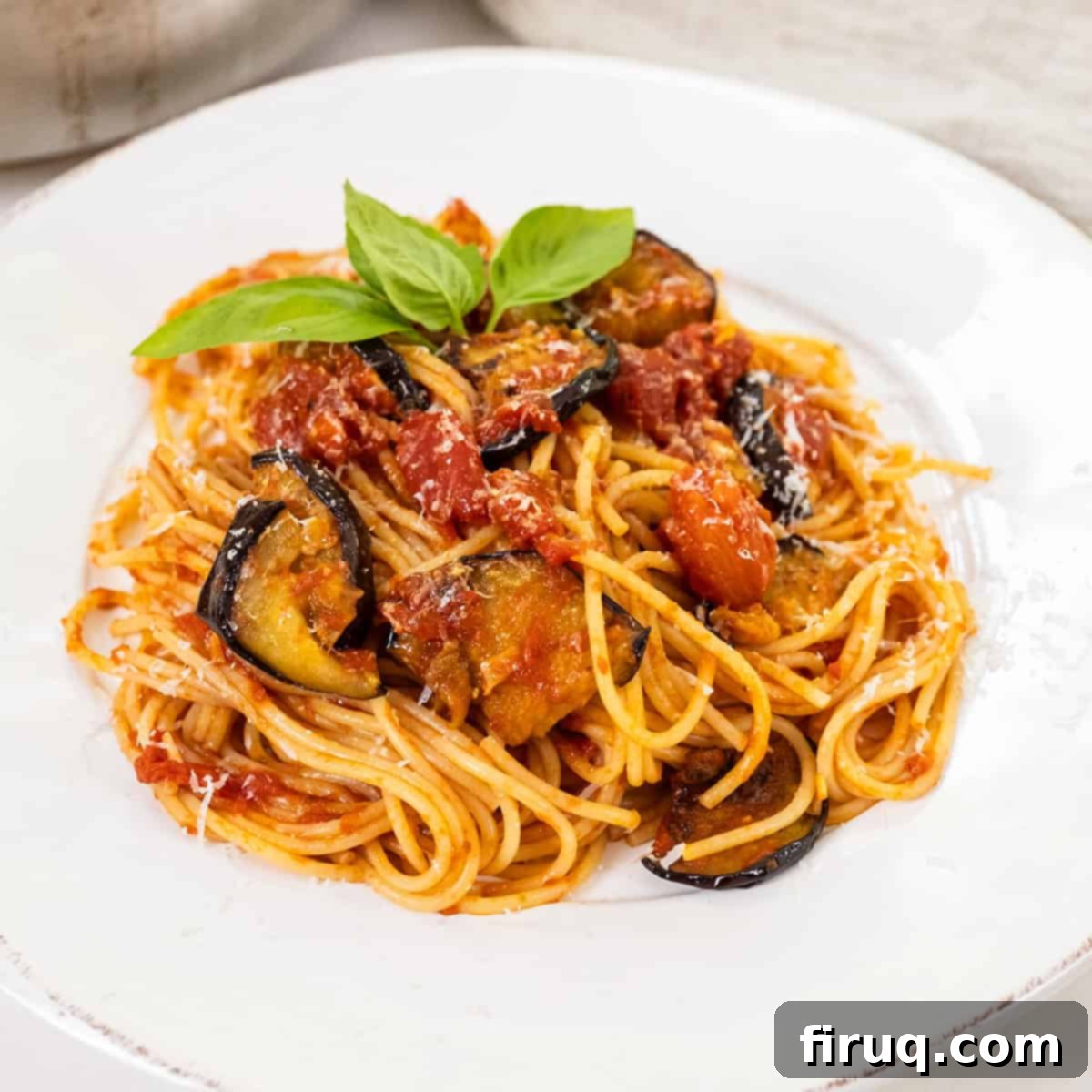Authentic Pasta alla Norma: A Timeless Sicilian Masterpiece with Fried Eggplant and Rich Tomato Sauce
Pasta alla Norma is more than just a dish; it’s a culinary icon from Sicily, celebrating the vibrant flavors of the Mediterranean. This classic recipe harmoniously combines tender, fried eggplant with a rich, savory tomato sauce, all tossed with your favorite pasta and finished with a generous grating of salty ricotta salata. It’s a dish that feels both elegant and comforting, surprisingly easy to whip up for a memorable weeknight family dinner, yet impressive enough for guests.
If you’re looking to explore more authentic Italian dishes that capture the essence of regional Italian cooking, consider trying Classic Linguine Alla Puttanesca, known for its bold flavors, or the fresh and light Italian Summer Pasta with Zucchini.
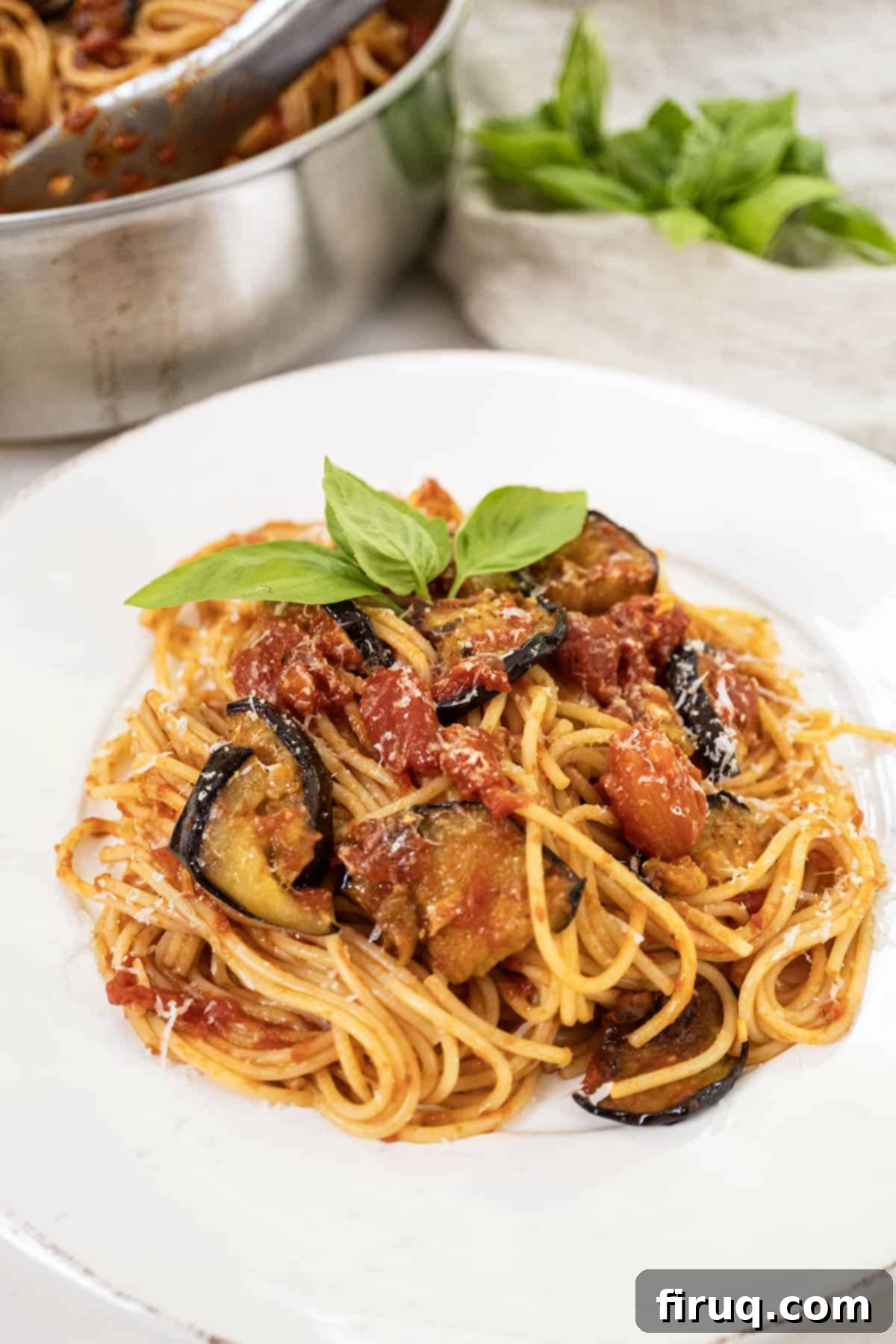
Craving more timeless Italian Classics? Be sure to try Spaghetti Carbonara, Bucatini Amatriciana, or the delightful Chicken Saltimbocca!
[feast_advanced_jump_to]
Why This Classic Sicilian Pasta Dish Will Become Your Favorite
Pasta alla Norma isn’t just a dish; it’s a staple you’ll find on almost every menu across Sicily, a true testament to its universal appeal and local pride. It’s a delightful concoction featuring succulent, almost “meaty” fried eggplant and a vibrant, sometimes spicy, marinara sauce, all lovingly served over perfectly cooked pasta. Just like Authentic Fettuccine Alfredo, it holds a special place in the pantheon of classic Italian cuisine.
What sets this recipe apart, and what I particularly love, is the method of cooking the eggplant. It retains its shape and a satisfying texture, rather than dissolving into a mush. While some simple eggplant pastas might embrace a softer, creamier eggplant, that texture doesn’t quite do justice to an authentic Pasta alla Norma. Here, the eggplant pieces are distinct, offering a wonderful contrast to the smooth tomato sauce.
For me, spotting genuine Pasta alla Norma on a menu is an irresistible invitation. There are just some dishes, like this or Italian Short Ribs, that are simply “must-order” items whenever I see them in an authentic Italian restaurant. This recipe aims to bring that restaurant-quality experience right into your kitchen.
The Story Behind Pasta alla Norma: A Culinary Masterpiece
The name “Pasta alla Norma” itself hints at the dish’s esteemed status. Originating in Catania, Sicily, it’s widely believed to have been named in honor of Vincenzo Bellini’s masterpiece opera, “Norma.” The legend goes that when the acclaimed playwright Nino Martoglio first tasted this pasta, he exclaimed, “Chista è ‘na vera Norma!” meaning “This is a true Norma!” implying it was as perfect and exquisite as Bellini’s opera. This instantly elevated the dish to a “masterpiece” in its own right.
This culinary masterpiece embodies the simple yet profound philosophy of Sicilian cooking: using fresh, high-quality, seasonal ingredients to create dishes that are rich in flavor and tradition. The combination of local eggplant, sun-ripened tomatoes, fresh basil, and robust ricotta salata tells a story of the fertile Sicilian land and its culinary heritage. Understanding this history adds another layer of appreciation to every delicious bite.
Ingredient Notes and Substitutions for Authentic Flavor
Creating an authentic Pasta alla Norma hinges on selecting the right ingredients. Here’s a detailed look at the key components and why they matter:
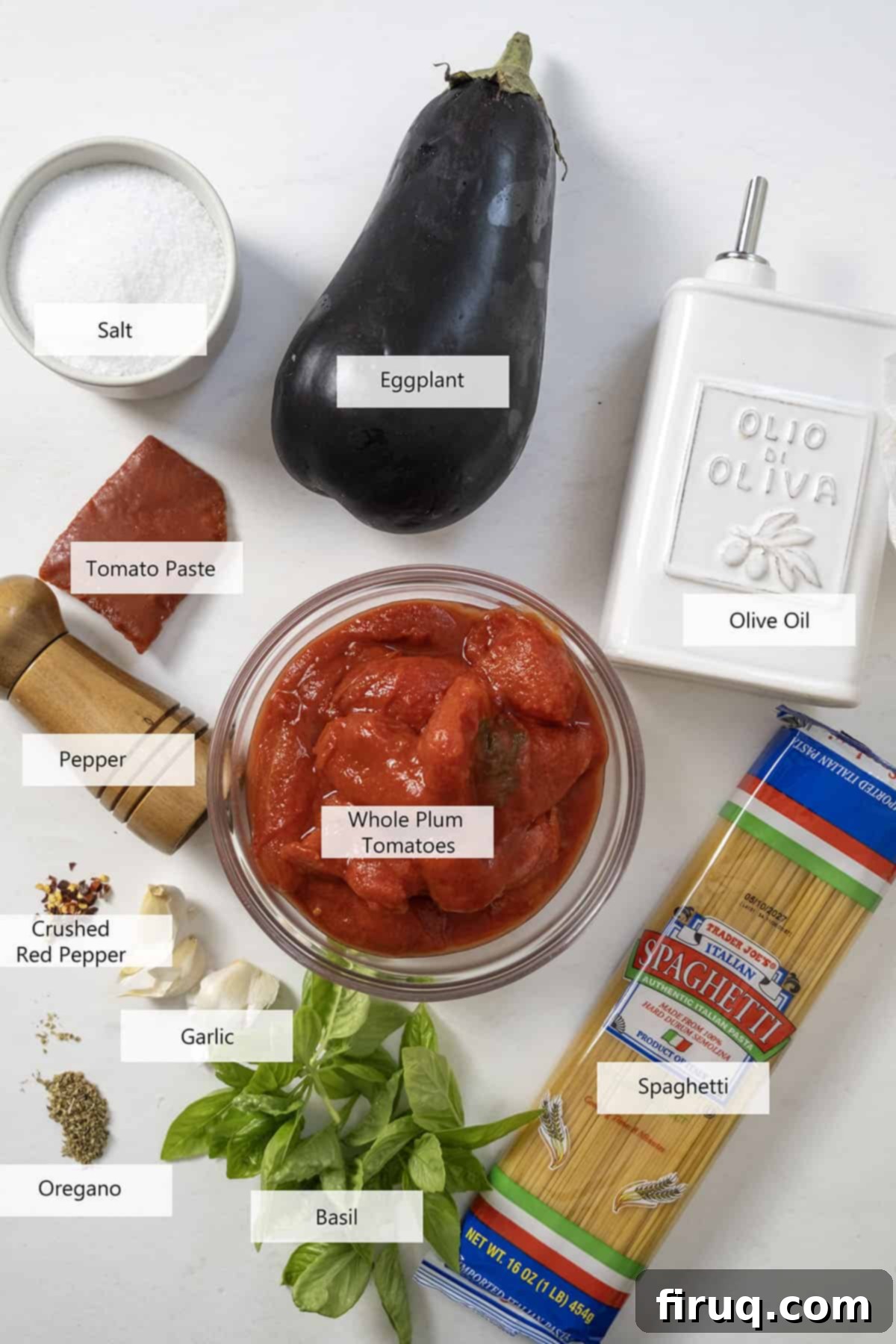
Whole Plum Tomatoes. For the most authentic and flavorful sauce, whole peeled plum tomatoes are non-negotiable. Look for high-quality brands, ideally San Marzano tomatoes, which are renowned for their sweet flavor and tender flesh. Do not substitute with crushed tomatoes unless absolutely necessary. Whole tomatoes allow you to control the texture by hand-crushing them in the pan, ensuring a rustic, textured sauce that is less processed and bursting with fresh tomato flavor. Crushed tomatoes are often too smooth and can lack the depth required for this dish.
Extra Virgin Olive Oil. This is crucial, especially when frying the eggplant. Eggplant acts like a sponge, soaking up a significant amount of oil. Using a high-quality extra virgin olive oil will impart a superior flavor to the eggplant and the entire dish. A lower quality oil will be noticeable and can detract from the overall taste. Don’t be shy with it; it’s part of what gives the eggplant its rich, satisfying texture and flavor.
Ricotta Salata. Traditionally, ricotta salata is the cheese of choice for Pasta alla Norma. It’s a firm, salted, and aged ricotta cheese that offers a distinct tangy, salty, and slightly “funky” flavor that is characteristic of the dish. In some regions, especially outside of Italy, true ricotta salata can be difficult to find or might be milder than its Sicilian counterpart. If you can’t find authentic ricotta salata, excellent substitutes include Grana Padano or Pecorino Romano. I personally often use Grana Padano for its balanced savory and slightly sweet notes that complement the sauce beautifully without overpowering it. Pecorino Romano offers a sharper, saltier kick, which is also wonderful if you prefer a bolder cheese flavor.
Pasta. While spaghetti is a popular choice, and what is used in this recipe, traditional Sicilian variations often use short pasta shapes like rigatoni, ziti, or macaroni. These shapes are excellent for capturing the rich tomato sauce and the diced eggplant pieces. Whatever shape you choose, opt for a high-quality, bronze-die cut pasta if possible. This type of pasta has a rougher surface, which allows the sauce to cling to it better, enhancing every bite.
Fresh Basil. The vibrant, aromatic flavor of fresh basil is essential. It brightens the rich sauce and adds an indispensable layer of authentic Italian taste. Always use fresh basil leaves, torn or roughly chopped, rather than dried basil, which simply won’t deliver the same fresh aroma and flavor.
*Please see the recipe card below for more information on ingredients.
Choosing and Preparing Your Eggplant for Perfection
The eggplant is the star of Pasta alla Norma, so choosing and preparing it correctly is paramount. Here are a few key considerations:
- Try to pick the smallest eggplant you can find. Smaller eggplants tend to have fewer seeds and a more tender flesh. Crucially, it should feel heavy for its size, indicating a good water content and firm texture.
- There’s a wide variety of eggplants available. The generic “eggplant” often found in supermarkets can be quite large and full of bitter seeds. For a superior texture and flavor in this dish, seek out specific varieties like Japanese eggplant, graffiti eggplant, or, ideally, Sicilian eggplant. These varieties are generally less bitter and have a better, more consistent texture that holds up well to frying.
- Always look for a firm vegetable that doesn’t bruise or yield too easily to the touch. The skin should be shiny and taut.
- **The Salting Process:** This step is critical and should not be skipped. Eggplants are naturally full of water and can sometimes be a bit bitter. Salting draws out this excess moisture and any potential bitterness, preventing the eggplant from becoming soggy and ensuring it fries up beautifully golden brown and tender, not steamed. After slicing your eggplant, lay the pieces on a flat surface, generously salt both sides, and let them sit for at least 20 minutes. You’ll see beads of moisture form on the surface. Afterward, pat them thoroughly dry with paper towels to remove all the water and excess salt before cutting them into smaller pieces for frying.
Step-by-Step Directions for Crafting Your Pasta alla Norma
This is a deceptively easy recipe. Like many classic Italian dishes, its greatness lies not in complexity, but in the simplicity of high-quality ingredients and careful attention to each step. Follow these directions to achieve an authentic and delicious result.
Step 1: Prepare the Eggplant. Begin by slicing your chosen eggplant into pieces slightly thinner than ½-inch. Arrange these slices on a clean, flat surface and generously salt both sides. Allow them to rest for 20 minutes; this crucial step draws out excess moisture and bitterness. After 20 minutes, use paper towels to thoroughly pat them dry, removing all released water and any remaining coarse salt. Then, cut these slices into quarters or halves, depending on their original size, aiming for pieces no larger than 1 inch by 1 inch. This ensures even cooking and a good bite.
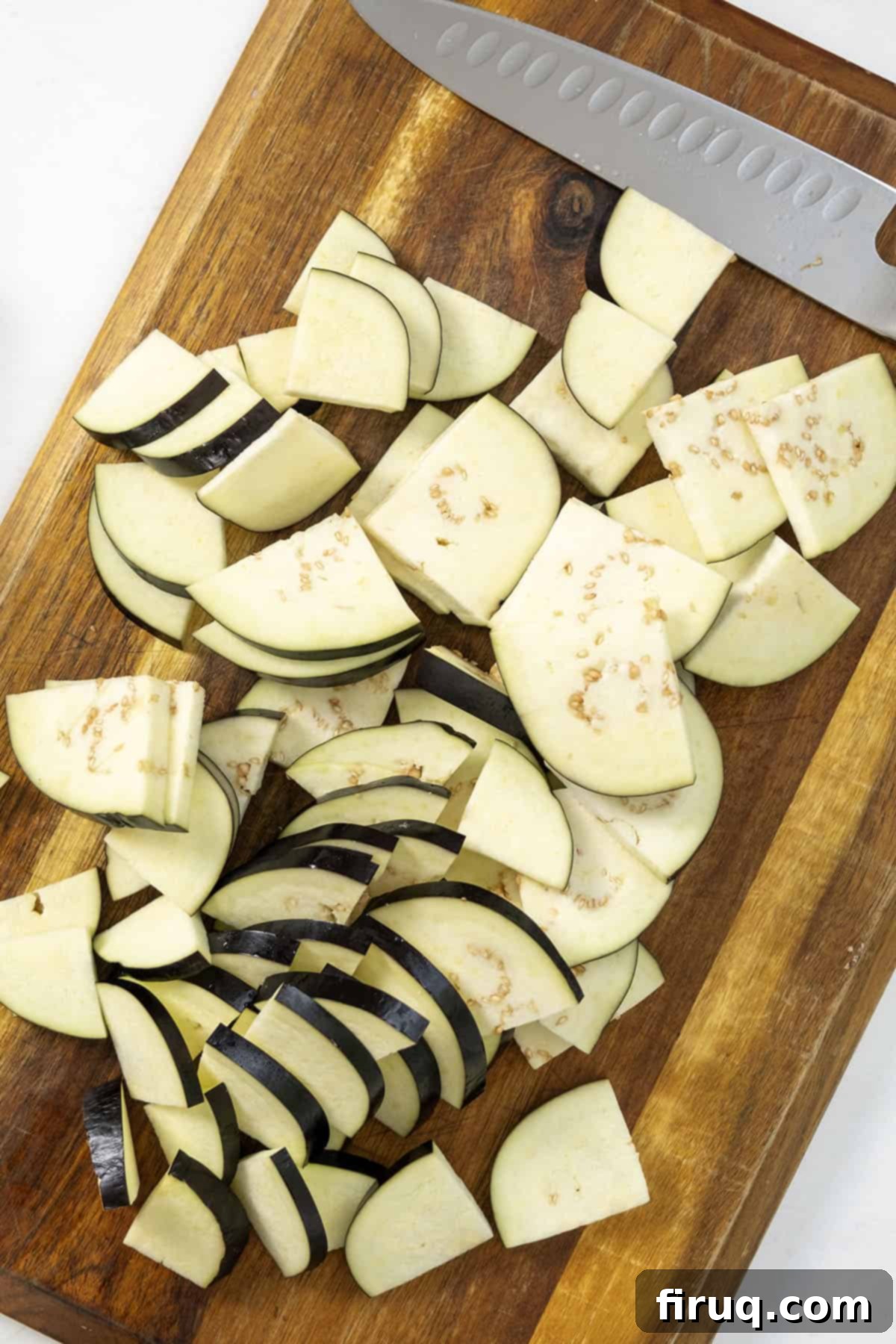
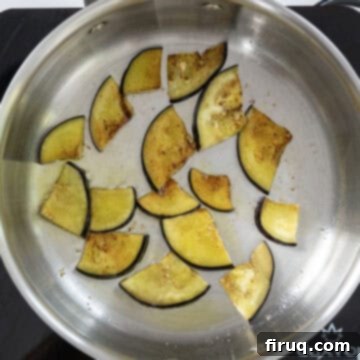
Step 2: Fry the Eggplant. Add approximately ¼ cup of good quality extra virgin olive oil to a large saucepan and heat it over medium heat. Once the oil begins to shimmer, carefully add the eggplant pieces in a single layer. Avoid overcrowding the pan; you may need to work in batches. Fry each batch until both sides are beautifully golden brown and tender, usually about 5 minutes per side. As eggplant is quite absorbent, you will likely need to add a little extra olive oil to the pan after each batch to ensure proper frying and prevent scorching. Once fried, transfer the eggplant to a plate lined with paper towels to drain any excess oil.
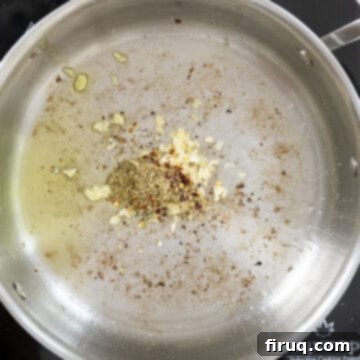
Step 3: Build the Sauce Base. With the eggplant set aside, add another tablespoon of fresh olive oil to the same pan. Reduce the heat to medium-low. Add the minced garlic, oregano, and crushed red pepper flakes. Sauté gently for about 30 seconds, or until the garlic becomes fragrant and lightly golden. Be careful not to burn the garlic, as this will make it bitter.

Step 4: Caramelize Tomato Paste. Add the tomato paste to the pan with the aromatics and stir it vigorously to combine everything. Cook for another 30 seconds, allowing the tomato paste to lightly caramelize. This step is key to deepening the tomato flavor and adding a rich umami note to the sauce.
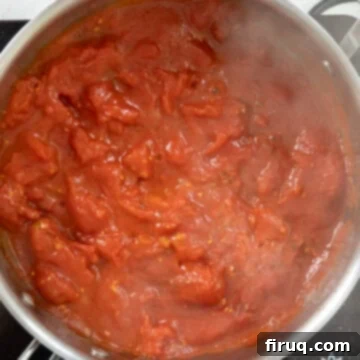
Step 5: Simmer the Tomato Sauce. Add the whole peeled tomatoes to the pan. Using a wooden spoon, gently break apart the tomatoes into smaller chunks, creating a rustic texture. Stir in the fresh basil leaves and the specified amount of salt. Bring the sauce to a gentle simmer and let it cook for at least 15 minutes. This simmering time allows the flavors to meld and deepen. In the meantime, bring a large pot of salted water to a rolling boil for your spaghetti, or preferred pasta shape.
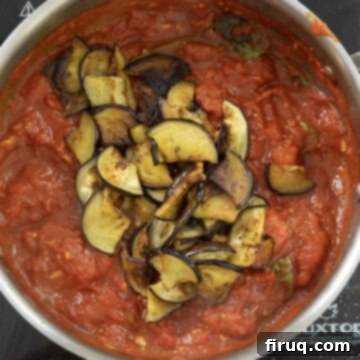
Step 6: Incorporate Eggplant and Pasta Water. Once your sauce has simmered, return the fried eggplant pieces to the pan. Just before straining your pasta, reserve about ¼ cup of the starchy pasta water. Add this reserved pasta water to the sauce. The starch helps to emulsify the sauce, creating a thicker, richer, and more cohesive coating for the pasta.
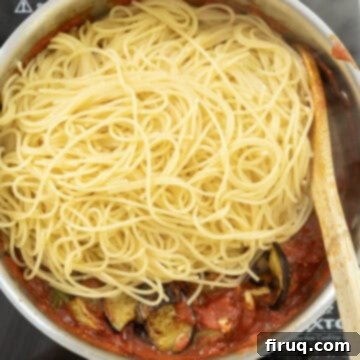
Step 7: Combine and Serve. Cook your spaghetti according to package directions until al dente. Strain the pasta, then immediately add it directly into the saucepan with the tomato and eggplant sauce. Toss vigorously to ensure the pasta is thoroughly coated with the delicious sauce. Serve immediately, garnished with freshly grated ricotta salata or grana padano and a few fresh basil leaves. Enjoy your homemade Sicilian masterpiece!
Pro-Tips for the Perfect Pasta alla Norma
- Patience with Frying the Eggplant: This step can feel like it’s taking a while, but patience is truly a virtue here. Do not rush the frying process. Ensure the heat is consistent (medium), and shake the pan occasionally to promote even cooking. Overcrowding the pan will lower the oil temperature and cause the eggplant to steam instead of fry, resulting in a less desirable texture. Fry in batches if necessary.
- Don’t Skip the Salting: As mentioned, eggplants are filled with water. If you bypass the crucial salting step, you’ll find it much harder to achieve that beautiful golden-brown color and tender texture when frying. The excess moisture will steam the eggplant, making it soggy and bland. This simple step makes all the difference in flavor and texture.
- Gentle Mixing is Key: Once the fried eggplant is back in the sauce, and especially when combining it with the pasta, mix gently. The goal is for the eggplant to maintain its shape and “meaty” texture, not to be crushed into a mush. Use tongs or a large spoon to carefully toss the ingredients together.
- High-Quality Olive Oil: Since eggplant absorbs a lot of oil, the quality of your extra virgin olive oil directly impacts the flavor of the entire dish. Invest in a good bottle for frying and for finishing.
- Al Dente Pasta: Always cook your pasta to a true al dente. It will finish cooking slightly in the warm sauce, ensuring a perfect texture.
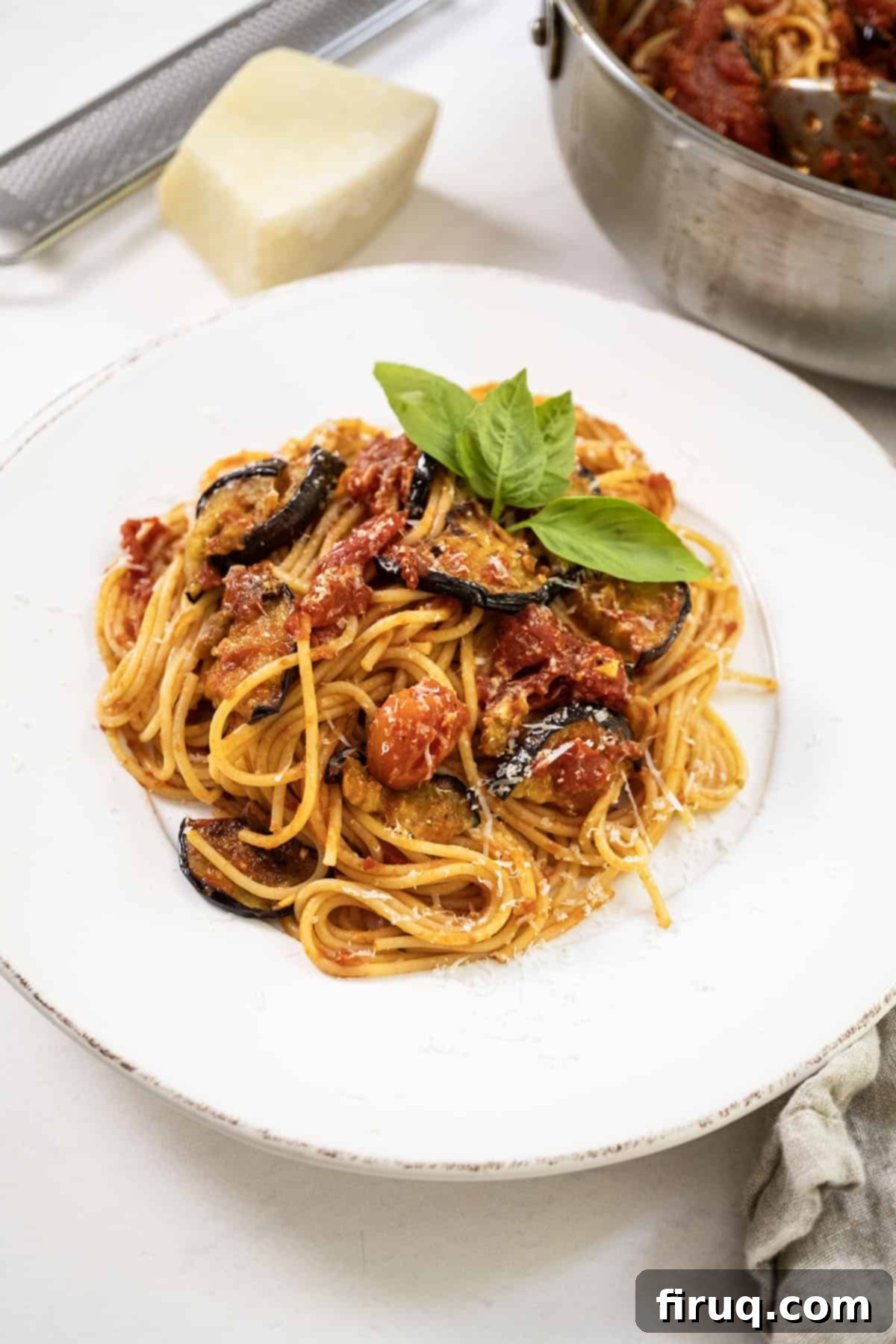
Pasta alla Norma is typically served as a primo, or “first dish,” in traditional Italian dining. Its rich flavors prepare the palate for a more substantial second course. It’s often followed by braised or grilled meats, which beautifully complement its savory profile, such as Authentic Italian Braciole, Classic Italian Fried Meatballs, or Grilled Stuffed Pork Chops. To complete the meal, consider serving it with a crusty loaf of Italian bread to soak up every last bit of the exquisite sauce, and perhaps a simple green salad dressed with olive oil and vinegar.
Recipe FAQs for Pasta alla Norma
Like most pasta dishes, Pasta alla Norma is best enjoyed fresh. However, if you have leftovers, it’s better to reheat them gently in a pan on the stovetop rather than in a microwave. Add a little extra olive oil or a splash of water/broth to loosen the sauce and prevent it from drying out. Heat over medium-low heat, stirring occasionally, until warmed through.
A Montepulciano will pair nicely with this pasta dish. With its deep fruit flavor, often hints of cherry and plum, and a subtle herbal or earthy note, this would be a great medium-bodied Italian red wine to complement the rich tomato sauce and savory eggplant without overpowering the dish. Other good options include a lighter-bodied Nero d’Avola, which is a native Sicilian grape, or a crisp, dry white wine like Vermentino if you prefer white.
As legend has it, “alla Norma” translates to “like Norma” or “a masterpiece” in Italian. This name was given to the dish because its exquisite flavor and perfect balance were deemed as grand and perfect as Vincenzo Bellini’s opera, “Norma,” which premiered in Catania, Sicily – the birthplace of this beloved pasta dish.
While best enjoyed fresh, you can prepare the tomato sauce and fry the eggplant ahead of time. Store them separately in airtight containers in the refrigerator for up to 2-3 days. When ready to serve, reheat the sauce and eggplant gently, cook fresh pasta, and combine as per the recipe. This method helps preserve the texture of the eggplant and the freshness of the pasta.
More Delightful Meatless Pasta Recipes
- Italian Summer Pasta with Zucchini
- Creamy Brie Pasta
- Pasta Primavera with Broccoli and Asparagus
- Creamy Red Pepper Sauce
We truly hope this detailed guide inspires you to create your own authentic Pasta alla Norma. It’s a dish that embodies the heart and soul of Sicilian cuisine, and one that is sure to become a beloved favorite in your home. The balance of savory eggplant, sweet tomato, and salty cheese is simply unmatched.
Please leave a comment and star rating below in the recipe card! We love to hear what you think of our recipes and how your culinary adventures turn out. Feel free to tag us on Instagram @vindelgiudice to share your beautiful creations!
📖 Recipe
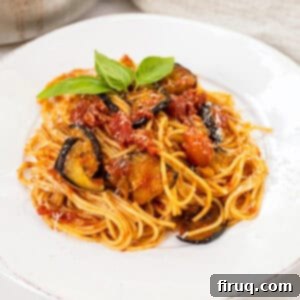
Pasta alla Norma
Vincent DelGiudice
Pin Recipe
Equipment
-
1 large saucepan
-
1 4-6 qt pot
Ingredients
- 1 eggplant, sliced in ½ inch slices
- 1 28 oz can peeled tomatoes (preferably San Marzano)
- 1 tbsp tomato paste
- 1 teaspoon salt, plus more for eggplant
- 4 cloves garlic, minced
- 1½ teaspoon dried oregano
- 1 teaspoon crushed red pepper (adjust to taste)
- 4-5 fresh basil leaves, torn or roughly chopped
- ½ cup high quality extra virgin olive oil (divided)
- ricotta salata or grana padano for garnish, freshly grated
- 1 lb spaghetti (or other short pasta shape like rigatoni)
Instructions
-
Begin by slicing your eggplant into ½-inch thick rounds or planks. Lay them out on a flat surface and liberally salt both sides. Let them rest for 20 minutes to allow the salt to draw out excess moisture. After 20 minutes, thoroughly pat the eggplant slices dry with paper towels to remove all the released water and excess salt. Then, cut these slices into quarters or halves, aiming for roughly 1-inch by 1-inch pieces.
-
Add about ¼ cup of high-quality extra virgin olive oil to a large saucepan and heat over medium heat until shimmering. Carefully add the prepared eggplant pieces in a single layer, ensuring not to overcrowd the pan. Fry until both sides are beautifully golden brown and tender, approximately 5 minutes per side. You may need to add additional olive oil as you fry successive batches, as eggplant tends to absorb a significant amount. Once cooked, remove the eggplant and set aside on a paper towel-lined plate to drain.
-
With the eggplant set aside, add another tablespoon of olive oil to the same pan if needed, and reduce the heat to medium-low. Add the minced garlic, dried oregano, and crushed red pepper flakes. Sauté for about 30 seconds, or until the garlic becomes fragrant but not browned. Stir in the tomato paste and cook for an additional 30 seconds, allowing it to lightly caramelize. Then, add the whole peeled tomatoes to the pan. Gently break them apart with a wooden spoon to create a rustic sauce. Stir in the fresh basil leaves and the remaining salt, then bring the sauce to a gentle simmer for 15 minutes, allowing the flavors to deepen. While the sauce simmers, bring a large pot of heavily salted water to a rolling boil for your pasta.
-
Cook the spaghetti according to package instructions until al dente. Before draining, reserve ¼ cup of the starchy pasta water. Drain the pasta and immediately add it to the simmering sauce along with the reserved pasta water. Toss vigorously to ensure the pasta is well coated. Gently fold in the fried eggplant pieces, being careful not to crush them. Serve immediately, garnished with freshly grated ricotta salata or grana padano and a few fresh basil leaves.
Notes
- Frying the Eggplant: This will feel like it’s taking longer than it should. Be patient and shake the pan occasionally. Moving the eggplant around can help them fry evenly. Avoid overcrowding the pan to ensure proper browning.
- Eggplants are filled with water. If you skip the salting step, it’ll be harder to get the eggplant to come out golden brown when frying it. It will also cause them to steam while cooking them, resulting in a soggy texture.
- Carefully mix the eggplant with the pasta to not crush it and make it mush. You want the eggplant pieces to remain distinct and tender.
- For the best flavor, use high-quality San Marzano whole peeled tomatoes for the sauce.
- Don’t forget the pasta water! The starch in the reserved pasta water helps emulsify the sauce, making it cling beautifully to the pasta.
